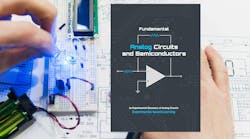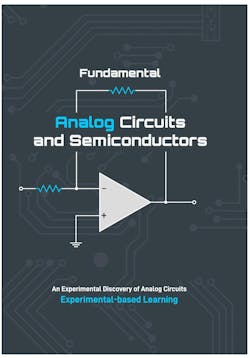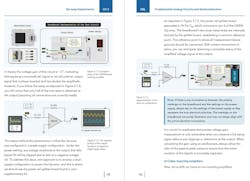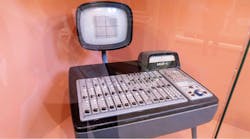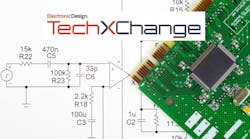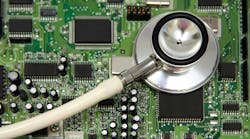What you’ll learn:
- A Kickstarter campaign for analog circuit breadboarding closed on July 6, 2024, receiving $112,613 in funding.
- There’s a new 300-page practical book on Analog Circuits and Semiconductors.
- A kit is available with the book, components, and a USB power splitter for +/- op-amp circuit powering.
- A lab package is available that includes the kit contents and adds a variable power supply and a pocket oscilloscope with function generator.
- Suitable for hobbyists, engineers, Makers, Arduino developers, schools, and other educational use
Back in eighth grade, a classmate of mine named Bruce brought in a transistor-circuit siren made by his older brother, which was installed in a transistor radio case. Immediately enchanted, I went to the library and tried to find a book on how to make one of those things.
This is when I stumbled onto the wonderful electronic project books by TAB Publishing, and authored by none other than Electronic Design editor alumnus Don Tuite—it was at this point when I got bitten by the bug to become an electrical engineer. Out of print now, one of Don’s electronics project books can still be found here in the Internet Archive.
Fast forward to 2024, and the team at EIM (Evo-in-motion) Technology will be releasing a 300-page how-to book where circuits are described for implementation using modern breadboarding techniques—a Kickstarter campaign closed on July 6, 2024 (a link to the campaign is *here*). Breadboard-friendly power supplies and rudimentary test-and-measurement equipment and kits of components will be available to accompany the book.
The book, Fundamental Analog Circuits and Semiconductors, should be available on the EIM website, click here, by the time of publication. Electronic Design readers can get a 20% discount by using coupon code “Nonlinearities20” at checkout as of the date this article is published.
The book itself is designed to provide just enough information to understand how analog and semiconductor components function, followed by copious examples and circuit “labs” described in color drawings. An excerpt of the book’s table of contents is here:
A description from EIM’s website of the chapters is as follows:
Chapter 1: Basics
- Review of fundamental concepts including basic circuit laws
- Detailed explanation of operational amplifiers, diodes, MOSFETs, and BJTs
- Aimed at providing readers with a solid understanding of underlying principles
- Includes 6 big sections with 33 sessions of topics
Chapter 2: Techniques
- Preparation for practical experimentation
- Equipment and tools list for hands-on learning
- Covers power supply, measurement techniques, grounding, and datasheet understanding
- Includes 5 big sections with 19 sessions of topics
Chapter 3: Op-amps
- Dive into op-amp experiments
- Starts with basic amplifiers and progresses to advanced configurations
- Explores practical op-amp applications and non-linear experiments
- Includes 4 big sections with 16 sessions of topics
Chapter 4: Diodes
- Focuses on diode experiments
- Covers diode characteristics, protection circuits, and rectifier circuits
- Hands-on experiments to analyze and design circuits using diodes
- Includes 4 big sections with 15 sessions of topics
Chapter 5: MOSFETs
- Delves into MOSFET experiments
- Explores fundamental characteristics and applications as switches
- Practical experiments to understand MOSFET behavior in various configurations
- Includes 3 big sections with 11 sessions of topics
Chapter 6: Bipolar Junction Transistors
- Explores BJT experiments
- Covers fundamental characteristics and applications as discrete amplifiers
- Hands-on experiments to analyze BJT behavior in different circuit setups
- Includes 3 big sections with 10 sessions of topics
Though the Kickstarter may have further discounts, and the coupon code may work on the EIM website when you read this in future, the book at $74 is here. A kit for $126, which includes the book, the components needed to breadboard the circuits in the book, and a breadboard Power Rail Splitter board that takes a USB input and produces ±5-V rails in the breadboard suitable for op amp circuits, can be found here. Below is an excerpt page of the book showing the Power Rail Splitter’s use (right page):
In addition, there’s The Lab, at $334, includes everything in the kit plus a pocket multimeter, a MEGO1 variable power supply that spans a breadboard (which was in their 2019 Kickstarter here), as well as a Zoolark2 pocket-sized oscilloscope and function generator. An excerpt page from the book shows the MEGO in use on page 135 in the image above (left page). For more details, visit EIM’s website at the link, above.
I may be doing a review of The Kit in my Nonlinearities blog at a future date. A link to it will be posted here if I do get time to have a look at it.
References
1. MEGO generates wide output DC voltage from 4 to 24 V with maximum output power of 6 W. The device is also designed to fit the standard 840-hole breadboards, so that you’re no longer bothered with the wiring headaches to power your circuit. The embedded 2000-mAh rechargeable lithium polymer battery makes it truly convenient for applications that require portable and immediate power.
2. Zoolark is a pocket-size electronics circuit testing and debugging tool that integrates features of a function generator, two-channel oscilloscope, fast digital I/O for PWM tuning, and high-accuracy DC reference output. A 240×240, full-color, 1.54-in. LCD clearly displays measurement results and testing information. The device is powered by a 280-mAh rechargeable lithium-polymer battery supporting over two hours standby time.
